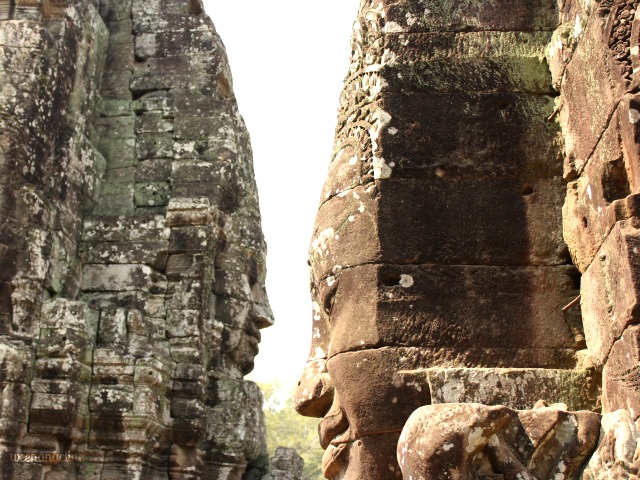After watching sunrise and walking around Angkor Wat, our guide brought us to Prasat Bayon (or Bayon Temple), which is located in the compound of Angkor Thom.
He parked before the entrance of the Angkor Thom, allowing us to experience walking through the gate.
The bridge over the moat surrounding Angkor Thom had statues of Gods and Demons on each side, carrying something which looks like a snake. If you noticed some of the photos in my Angkor Wat post also had carvings of this.
It's actually from a Hindu mythology called the Churning of the Ocean of Milk, where these Gods and Demons worked together to churn the milk ocean by doing "tug-of-war" using Vasuki, a giant serpent, coiled around Mt. Mandala. The purpose was to obtain some sort of elixir of immortality.
The opening of the entrance is actually very small, so vehicles need to be cautious when entering Angkor Thom. Not only they have to compete with other vehicles, they also need to be careful with visitors!
Short video of us walking towards the entrance:
Elephants with riders (warriors? Gods?)! Looked like they are supporting the whole gate!
The darker parts of the statues are products of restoration efforts.
Then we drove further in to go Prasat Bayon which was built at the end of the 12th century.
Look at how gorgeous the structure is!
He took us aside and briefed us on the history of the temple. Which we listened half-sleepily, since we woke up at about 4.30 am earlier.
Felt bad but cannot help it lahhh. I think he could sense it but I guess hedie die also had to tell us the history of this temple.
Such a beautiful background for a photo.
Video~
Just like Angkor Wat, the carvings on the walls of Prasat Bayon are just beyond amazing.
As you can see, the most fascinating thing about this temple is the many towers with faces, which I initially mistook as the Phra Phrom when I look up about Bayon on the internet.
Turns out that these faces are actually the images of the of King Jayavarman VII, the rulers after him, Gods, and etc.
One would think that the official religion of Siem Reap at that time was Buddhism; however did you know that at some points Hinduism was also practised?
Hence you can see a mixture of Buddhism and Hinduism influences in their historical sites.
Honestly speaking, I'm actually amazed by how people those days can manage to construct such detailed structures!
Thanks for dropping by! Next up will be on Prasat Taney and Wat Thmey, which we also visited on the same day!
The bridge over the moat surrounding Angkor Thom had statues of Gods and Demons on each side, carrying something which looks like a snake. If you noticed some of the photos in my Angkor Wat post also had carvings of this.
It's actually from a Hindu mythology called the Churning of the Ocean of Milk, where these Gods and Demons worked together to churn the milk ocean by doing "tug-of-war" using Vasuki, a giant serpent, coiled around Mt. Mandala. The purpose was to obtain some sort of elixir of immortality.
 |
| the broken body of Vasuki |
The opening of the entrance is actually very small, so vehicles need to be cautious when entering Angkor Thom. Not only they have to compete with other vehicles, they also need to be careful with visitors!
 |
| ok i know my face is horrible but must show haha |
Short video of us walking towards the entrance:
On the other side of the entrance our guide drove to meet us and told us to observe the structure.
Elephants with riders (warriors? Gods?)! Looked like they are supporting the whole gate!
The darker parts of the statues are products of restoration efforts.
 |
| only two of us because the boys went missing haha |
Then we drove further in to go Prasat Bayon which was built at the end of the 12th century.
Look at how gorgeous the structure is!
He took us aside and briefed us on the history of the temple. Which we listened half-sleepily, since we woke up at about 4.30 am earlier.
Felt bad but cannot help it lahhh. I think he could sense it but I guess he
 |
| okaylah as a reward take his photo hehe |
Such a beautiful background for a photo.
Video~
Just like Angkor Wat, the carvings on the walls of Prasat Bayon are just beyond amazing.
As you can see, the most fascinating thing about this temple is the many towers with faces, which I initially mistook as the Phra Phrom when I look up about Bayon on the internet.
Turns out that these faces are actually the images of the of King Jayavarman VII, the rulers after him, Gods, and etc.
One would think that the official religion of Siem Reap at that time was Buddhism; however did you know that at some points Hinduism was also practised?
Hence you can see a mixture of Buddhism and Hinduism influences in their historical sites.
Honestly speaking, I'm actually amazed by how people those days can manage to construct such detailed structures!
 |
| gawd i have an ugly butt |
 |
| thanks CS! |
 |
| smile for the camera! |
 |
| the fallen structures |
Thanks for dropping by! Next up will be on Prasat Taney and Wat Thmey, which we also visited on the same day!




















































No comments:
Post a Comment
comment away and don't forget to tick the "Notify me" box, or else I'll miss your messages and won't reply :'(